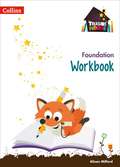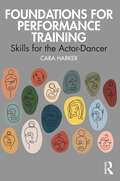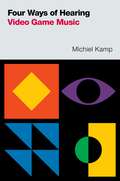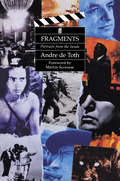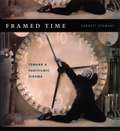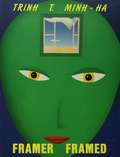- Table View
- List View
Foundation Workbook (PDF)
by Alison Milford Lindsay Pickton Christine Chen Collins StaffFoundation Treasure House is a topic-based resource consisting of mini-storytelling projects. Each project focuses on an exciting and engaging core text, with a bank of activities linked to the text. All 40-60+ month reading and writing early years outcomes are covered within the topics. The bank of activities for each project is the vehicle for teaching speaking and listening skills, early reading skills (phonics), early writing skills and related reinforcement. There are lots of suggestions for incorporating more cross-curricular and creative activities within the topic. The Workbook is phonics-based and linked the reading and writing Early Learning Goals. It can be used for practice, for exemplification and to support teacher judgement of the EYFS and completion of the EYFS profile.
Foundations for Performance Training: Skills for the Actor-Dancer
by Cara HarkerFoundations for Performance Training: Skills for the Actor-Dancer explores the physical, emotional, theoretical, and practical components of performance training in order to equip readers with the tools needed to successfully advance in their development as artists and entertainers.Each chapter provides a fresh perspective on subjects that students of acting and dance courses encounter throughout their training as performing artists. Topics include: Equity, diversity, and inclusion in performance Mind/body conditioning for training, rehearsal, and performance Developing stage presence and spatial awareness Cultivating motivation and intention in performance Expanding repertoire and broadening skillset for performance Auditioning for film and stage Developing theatrical productions This book also offers experiential exercises, journal writing prompts, and assignments to engage readers, enrich their learning experience, and deepen their exploration of the material described in each chapter. Readers will grow as performing artists as they analyze the principles of both acting and dance and discover how deeply the two art forms are intertwined.An excellent resource for students of acting, musical theatre, and dance courses, Foundations for Performance Training encourages a strong foundation in creative analysis, technique, artistic expression, and self-care to cultivate excellence in performance.
Foundations for Performance Training: Skills for the Actor-Dancer
by Cara HarkerFoundations for Performance Training: Skills for the Actor-Dancer explores the physical, emotional, theoretical, and practical components of performance training in order to equip readers with the tools needed to successfully advance in their development as artists and entertainers.Each chapter provides a fresh perspective on subjects that students of acting and dance courses encounter throughout their training as performing artists. Topics include: Equity, diversity, and inclusion in performance Mind/body conditioning for training, rehearsal, and performance Developing stage presence and spatial awareness Cultivating motivation and intention in performance Expanding repertoire and broadening skillset for performance Auditioning for film and stage Developing theatrical productions This book also offers experiential exercises, journal writing prompts, and assignments to engage readers, enrich their learning experience, and deepen their exploration of the material described in each chapter. Readers will grow as performing artists as they analyze the principles of both acting and dance and discover how deeply the two art forms are intertwined.An excellent resource for students of acting, musical theatre, and dance courses, Foundations for Performance Training encourages a strong foundation in creative analysis, technique, artistic expression, and self-care to cultivate excellence in performance.
Foundations of Flat Patterning and Draping: For the Female Form
by Larissa McConnellFoundations of Flat Patterning and Draping: For the Female Form provides the foundational tools necessary for success in the techniques of flat patterning and draping clothes and costumes. This book begins with the basics of taking measurements, preparing the fabric for draping, and preparing the dress form. The following chapters explore flat patterning and draping practices for bodices, skirts, pants, dresses, sleeves, collars, cuffs, and facings through detailed step-by-step instructions, checklists, and numerous diagrams. The bodice drafting instructions in this book, specifically, are a new method that accommodates all bust and cup sizes. There are instructions for small and large cup sizes allowing for a fit that does not gap at the armscye as typically happens with previous patterning methods, and additional sections for bodices and sleeves and how to manipulate them to create alternate looks. The techniques in this book generalize across sizes and shapes making it universally applicable for the student technician, as well as the person the garment is being developed for. Each method of drafting and draping has been class-tested and proven to produce well-fitting garments. Presented in an accessible format with clear instructions and detailed illustrations, this book is well suited for use as a textbook for the undergraduate college instructor teaching costuming or fashion, as well as for the student or individual learning on their own in theatre, film, or fashion industries.
Foundations of Flat Patterning and Draping: For the Female Form
by Larissa McConnellFoundations of Flat Patterning and Draping: For the Female Form provides the foundational tools necessary for success in the techniques of flat patterning and draping clothes and costumes. This book begins with the basics of taking measurements, preparing the fabric for draping, and preparing the dress form. The following chapters explore flat patterning and draping practices for bodices, skirts, pants, dresses, sleeves, collars, cuffs, and facings through detailed step-by-step instructions, checklists, and numerous diagrams. The bodice drafting instructions in this book, specifically, are a new method that accommodates all bust and cup sizes. There are instructions for small and large cup sizes allowing for a fit that does not gap at the armscye as typically happens with previous patterning methods, and additional sections for bodices and sleeves and how to manipulate them to create alternate looks. The techniques in this book generalize across sizes and shapes making it universally applicable for the student technician, as well as the person the garment is being developed for. Each method of drafting and draping has been class-tested and proven to produce well-fitting garments. Presented in an accessible format with clear instructions and detailed illustrations, this book is well suited for use as a textbook for the undergraduate college instructor teaching costuming or fashion, as well as for the student or individual learning on their own in theatre, film, or fashion industries.
Foundations of Stage Makeup
by Daniel TownsendFoundations of Stage Makeup is a comprehensive exploration into the creative world of stage makeup. Step-by-step makeup applications paired with textual content create an enriching experience for future performers and makeup artists. Students will learn relevant history, color theory, makeup sanitation processes, and the use of light and shadow to engage in discussions about the aspects of professional makeup. Those foundations are then paired with a semester’s-worth of descriptive, engaging makeup applications. Old age makeup, blocking out eyebrows, gory burns, and creating fantastical creatures are just a few of the rewarding techniques found in Foundations of Stage Makeup. The book is complemented by an eResource page featuring makeup tutorials and an instructor’s manual with example assignments and tips to teaching each chapter.
Foundations of Stage Makeup
by Daniel C TownsendFoundations of Stage Makeup is a comprehensive exploration into the creative world of stage makeup. Step-by-step makeup applications paired with textual content create an enriching experience for future performers and makeup artists. Students will learn relevant history, color theory, makeup sanitation processes, and the use of light and shadow to engage in discussions about the aspects of professional makeup. Those foundations are then paired with a semester’s-worth of descriptive, engaging makeup applications. Old age makeup, blocking out eyebrows, gory burns, and creating fantastical creatures are just a few of the rewarding techniques found in Foundations of Stage Makeup. The book is complemented by an eResource page featuring makeup tutorials and an instructor’s manual with example assignments and tips to teaching each chapter.
Four from the forties: Arliss, Crabtree, Knowles and Huntington (British Film-Makers)
by Brian McFarlaneThis is a book for those who love British cinema and want to know more about its rise to popularity in the 1940s. The ‘quality’ films of the decade have been thoroughly explored already, but this book looks at the films the public actually went to see, and provides detailed information on the directors behind them.
Four from the forties: Arliss, Crabtree, Knowles and Huntington (British Film-Makers)
by Brian McFarlaneThe ‘Gainsborough melodramas’ were a mainstay of 1940s British cinema, and helped make the careers of such stars as Margaret Lockwood, James Mason and Stewart Granger. But what was unique about these films? And who were the directors behind them? This book presents four key filmmakers, each with his own talents and specialities. It traces their professional lives through the highs of the 1940s, when the popularity of Gainsborough films was at its peak, to the tougher decades that followed the genre’s decline. Featuring expert analysis of such films as The Man in Grey (1943), Madonna of the Seven Moons (1945) and The Upturned Glass (1947), alongside valuable historical context, the book constitutes the first extended examination of this group of directors. It combines critical acumen with readability, making it a valuable resource for students, lecturers and general readers alike.
Four Ways of Hearing Video Game Music (Oxford Music / Media)
by Michiel KampFour Ways of Hearing Video Game Music offers a novel account of the ways in which video games invite us to hear and listen to their music. By taking a phenomenological approach to characterize music in video games, author Michiel Kamp asks what it is we hear in the music when we play a game. Drawing on past phenomenological approaches to music as well as studies of music listening in a variety of disciplines such as aesthetics and ecological psychology, Kamp explains four main ways of hearing the same piece of music--through background, aesthetic, ludic, and semiotic hearing. As a background, music is not attended to at all, but can still be described in terms of moods, affordances, or equipment. Aesthetic hearing is a reflective attitude that invites hermeneutic interpretation; ludic hearing on the other hand invites "playing along" to the music, either through embodied movement, or in response to the music's cinematic or theatrical connotations. Finally, in semiotic hearing, Kamp argues that we hear music as transparent symbols or signals that provide information about the state of a game. The book investigates these four categories through detailed case studies of video games from a variety of eras and genres accompanied by gameplay recordings and images on a companion website.
Four Ways of Hearing Video Game Music (Oxford Music / Media)
by Michiel KampFour Ways of Hearing Video Game Music offers a novel account of the ways in which video games invite us to hear and listen to their music. By taking a phenomenological approach to characterize music in video games, author Michiel Kamp asks what it is we hear in the music when we play a game. Drawing on past phenomenological approaches to music as well as studies of music listening in a variety of disciplines such as aesthetics and ecological psychology, Kamp explains four main ways of hearing the same piece of music--through background, aesthetic, ludic, and semiotic hearing. As a background, music is not attended to at all, but can still be described in terms of moods, affordances, or equipment. Aesthetic hearing is a reflective attitude that invites hermeneutic interpretation; ludic hearing on the other hand invites "playing along" to the music, either through embodied movement, or in response to the music's cinematic or theatrical connotations. Finally, in semiotic hearing, Kamp argues that we hear music as transparent symbols or signals that provide information about the state of a game. The book investigates these four categories through detailed case studies of video games from a variety of eras and genres accompanied by gameplay recordings and images on a companion website.
Fractured Fifties: The Cinematic Periodization and Evolution of a Decade
by Christine SprenglerThe 1950s as a cultural concept has surged with astonishing force over the last half century. Cultural and political investment in the postwar era has been heavily determined by the desires, anxieties, ideologies, and technologies of the contexts in which they surface. In this book author Christine Sprengler explores how contextualizing factors shaped the 1950s in different ways, and how cinematic representations spearheaded, challenged, or intervened in our cultural memories of the era. Fractured Fifties: The Cinematic Periodization and Evolution of a Decade presents a two-pronged argument that cinema helped define the 1950s by contributing in considerable and meaningful ways to the process of periodization and subsequently a common conception of the decade, and that cinema itself has fractured our understanding of the 1950s. Fractured Fifties challenges a reductive and fairly cohesive set of tropes with a complex amalgam of representations that also intervene in debates about historiography, historicity, cultural memory, mediation, nostalgia, and periodization. Ultimately, Sprengler posits that cinema has complicated our sense of the 1950s, yielding in the process a series of 1950s types or kinds, (e.g., The Leave it to Beaver Fifties, The Jukebox Fifties, and The Cold War Fifties, The Retromediated Fifties) as well as a wealth of critical insights into myriad pasts, presents, and the evolving relationships between them.
Fractured Fifties: The Cinematic Periodization and Evolution of a Decade
by Christine SprenglerThe 1950s as a cultural concept has surged with astonishing force over the last half century. Cultural and political investment in the postwar era has been heavily determined by the desires, anxieties, ideologies, and technologies of the contexts in which they surface. In this book author Christine Sprengler explores how contextualizing factors shaped the 1950s in different ways, and how cinematic representations spearheaded, challenged, or intervened in our cultural memories of the era. Fractured Fifties: The Cinematic Periodization and Evolution of a Decade presents a two-pronged argument that cinema helped define the 1950s by contributing in considerable and meaningful ways to the process of periodization and subsequently a common conception of the decade, and that cinema itself has fractured our understanding of the 1950s. Fractured Fifties challenges a reductive and fairly cohesive set of tropes with a complex amalgam of representations that also intervene in debates about historiography, historicity, cultural memory, mediation, nostalgia, and periodization. Ultimately, Sprengler posits that cinema has complicated our sense of the 1950s, yielding in the process a series of 1950s types or kinds, (e.g., The Leave it to Beaver Fifties, The Jukebox Fifties, and The Cold War Fifties, The Retromediated Fifties) as well as a wealth of critical insights into myriad pasts, presents, and the evolving relationships between them.
Fragments: Portraits From The Inside
by Andre de TothAndre de Toth's remarkable, eccentric and utterly compelling memoir opens amidst the enchanted cafe society of pre-war Budapest. With a novelist's sense of time and place he propels the reader through a series of snap-shots from his fantastically eventful life, from Vienna, Paris and London to Hollywood - where he encountered many of the legendary figures of cinema's golden age.Ever the maverick, de Toth avoids the anodyne cliches of the show biz biography. Brutally honest and frequently self-deprecating, Fragments is a memoir with bite.Also included is an illuminating preface by Bertrand Tavernier.
Framed Time: Toward a Postfilmic Cinema (Cinema and Modernity)
by Garrett StewartItalian director Michelangelo Antonioni claimed, three decades ago, that different conceptions of time helped define the split in film between European humanism and American science fiction. And as Garrett Stewart argues here, this transatlantic division has persisted since cinema’s 1995 centenary, made more complex by the digital technology that has detached movies from their dependence on the sequential frames of the celluloid strip. Brilliantly interpreting dozens of recent films—from Being John Malkovich, Donnie Darko, and The Sixth Sense to La mala educación and Caché —Stewart investigates how their treatments of time reflect the change in media from film’s original rolling reel to today’s digital pixel. He goes on to show—with 140 stills—how American and European narratives confront this shift differently: while Hollywood movies tend to revolve around ghostly afterlives, psychotic doubles, or violent time travel, their European counterparts more often feature second sight, erotic telepathy, or spectral memory. Stewart questions why these recent plots, in exploring temporality, gravitate toward either supernatural or uncanny apparitions rather than themes of digital simulation. In doing so, he provocatively continues the project he began with Between Film and Screen, breaking new ground in visual studies, cinema history, and media theory.
Framed Time: Toward a Postfilmic Cinema (Cinema and Modernity)
by Garrett StewartItalian director Michelangelo Antonioni claimed, three decades ago, that different conceptions of time helped define the split in film between European humanism and American science fiction. And as Garrett Stewart argues here, this transatlantic division has persisted since cinema’s 1995 centenary, made more complex by the digital technology that has detached movies from their dependence on the sequential frames of the celluloid strip. Brilliantly interpreting dozens of recent films—from Being John Malkovich, Donnie Darko, and The Sixth Sense to La mala educación and Caché —Stewart investigates how their treatments of time reflect the change in media from film’s original rolling reel to today’s digital pixel. He goes on to show—with 140 stills—how American and European narratives confront this shift differently: while Hollywood movies tend to revolve around ghostly afterlives, psychotic doubles, or violent time travel, their European counterparts more often feature second sight, erotic telepathy, or spectral memory. Stewart questions why these recent plots, in exploring temporality, gravitate toward either supernatural or uncanny apparitions rather than themes of digital simulation. In doing so, he provocatively continues the project he began with Between Film and Screen, breaking new ground in visual studies, cinema history, and media theory.
Framed Time: Toward a Postfilmic Cinema (Cinema and Modernity)
by Garrett StewartItalian director Michelangelo Antonioni claimed, three decades ago, that different conceptions of time helped define the split in film between European humanism and American science fiction. And as Garrett Stewart argues here, this transatlantic division has persisted since cinema’s 1995 centenary, made more complex by the digital technology that has detached movies from their dependence on the sequential frames of the celluloid strip. Brilliantly interpreting dozens of recent films—from Being John Malkovich, Donnie Darko, and The Sixth Sense to La mala educación and Caché —Stewart investigates how their treatments of time reflect the change in media from film’s original rolling reel to today’s digital pixel. He goes on to show—with 140 stills—how American and European narratives confront this shift differently: while Hollywood movies tend to revolve around ghostly afterlives, psychotic doubles, or violent time travel, their European counterparts more often feature second sight, erotic telepathy, or spectral memory. Stewart questions why these recent plots, in exploring temporality, gravitate toward either supernatural or uncanny apparitions rather than themes of digital simulation. In doing so, he provocatively continues the project he began with Between Film and Screen, breaking new ground in visual studies, cinema history, and media theory.
Framer Framed: Film Scripts and Interviews
by Trinh T. Minh-haFramer Framed brings together for the first time the scripts and detailed visuals of three of Trinh Minh-ha's provocative films: Reassemblage, Naked Spaces--Living is Round, and Surname Viet Given Name Nam.
Framer Framed: Film Scripts and Interviews
by Trinh T. Minh-haFramer Framed brings together for the first time the scripts and detailed visuals of three of Trinh Minh-ha's provocative films: Reassemblage, Naked Spaces--Living is Round, and Surname Viet Given Name Nam.
Frames and Framing in Documentary Comics (Palgrave Studies in Comics and Graphic Novels)
by Johannes C.P. SchmidFrames and Framing in Documentary Comics explores how graphic narratives reframe global crises while also interrogating practices of fact-finding. An analog print phenomenon in an era shaped by digitalization, documentary comics formulates a distinct counterapproach to conventional journalism. In what ways are ‘facts’ being presented and framed? What is documentary honesty in a world of fake news and post-truth politics? How can the stories of marginalized peoples and neglected crises be told? The author investigates documentary comics in its unique relationship to framing: graphic narratives are essentially shaped by a reciprocal relationship between the manifest frames on the page and the attention to the cognitive frames that they generate. To account for both the textuality of comics and its strategic use as rhetoric, the author combines theories of framing analysis and cognitive narratology with comics studies and its attention toward the medium’s visual frames.
Framing Africa: Portrayals of a Continent in Contemporary Mainstream Cinema
by Nigel EltringhamThe first decade of the 21st century has seen a proliferation of North American and European films that focus on African politics and society. While once the continent was the setting for narratives of heroic ascendancy over self (The African Queen, 1951; The Snows of Kilimanjaro, 1952), military odds (Zulu, 1964; Khartoum, 1966) and nature (Mogambo, 1953; Hatari!,1962; Born Free, 1966; The Last Safari, 1967), this new wave of films portrays a continent blighted by transnational corruption (The Constant Gardener, 2005), genocide (Hotel Rwanda, 2004; Shooting Dogs, 2006), ‘failed states’ (Black Hawk Down, 2001), illicit transnational commerce (Blood Diamond, 2006) and the unfulfilled promises of decolonization (The Last King of Scotland, 2006). Conversely, where once Apartheid South Africa was a brutal foil for the romance of East Africa (Cry Freedom, 1987; A Dry White Season, 1989), South Africa now serves as a redeemed contrast to the rest of the continent (Red Dust, 2004; Invictus, 2009). Writing from the perspective of long-term engagement with the contexts in which the films are set, anthropologists and historians reflect on these films and assess the contemporary place Africa holds in the North American and European cinematic imagination.
Framing Celebrity: New directions in celebrity culture
by Su Holmes Sean RedmondCelebrity culture has a pervasive presence in our everyday lives – perhaps more so than ever before. It shapes not simply the production and consumption of media content but also the social values through which we experience the world. This collection analyses this phenomenon, bringing together essays which explore celebrity across a range of media, cultural and political contexts. The authors investigate topics such as the intimacy of fame, political celebrity, stardom in American ‘quality’ television (Sarah Jessica Parker), celebrity 'reality' TV (I’m a Celebrity … Get Me Out of Here!), the circulation of the porn star, the gallery film (David/David Beckham), the concept of cartoon celebrity (The Simpsons), fandom and celebrity (k.d. lang, *NSYNC), celebrity in the tabloid press, celebrity magazines (heat, Celebrity Skins), the fame of the serial killer and narratives of mental illness in celebrity culture. The collection is organized into four themed sections: Fame Now broadly examines the contemporary contours of fame as they course through new media sites (such as 'reality' TV and the internet) and different social, cultural and political spaces. Fame Body attempts to situate the star or celebrity body at the centre of the production, circulation and consumption of contemporary fame. Fame Simulation considers the increasingly strained relationship between celebrity and artifice and ‘authenticity’. Fame Damage looks at the way the representation of fame is bound up with auto-destructive tendencies or dissolution.
Framing Celebrity: New directions in celebrity culture
by Su Holmes Sean RedmondCelebrity culture has a pervasive presence in our everyday lives – perhaps more so than ever before. It shapes not simply the production and consumption of media content but also the social values through which we experience the world. This collection analyses this phenomenon, bringing together essays which explore celebrity across a range of media, cultural and political contexts. The authors investigate topics such as the intimacy of fame, political celebrity, stardom in American ‘quality’ television (Sarah Jessica Parker), celebrity 'reality' TV (I’m a Celebrity … Get Me Out of Here!), the circulation of the porn star, the gallery film (David/David Beckham), the concept of cartoon celebrity (The Simpsons), fandom and celebrity (k.d. lang, *NSYNC), celebrity in the tabloid press, celebrity magazines (heat, Celebrity Skins), the fame of the serial killer and narratives of mental illness in celebrity culture. The collection is organized into four themed sections: Fame Now broadly examines the contemporary contours of fame as they course through new media sites (such as 'reality' TV and the internet) and different social, cultural and political spaces. Fame Body attempts to situate the star or celebrity body at the centre of the production, circulation and consumption of contemporary fame. Fame Simulation considers the increasingly strained relationship between celebrity and artifice and ‘authenticity’. Fame Damage looks at the way the representation of fame is bound up with auto-destructive tendencies or dissolution.
Framing Pictures: Film and the Visual Arts (Edinburgh Studies in Film and Intermediality (PDF))
by Steven JacobsThrough the feature films and documentaries of directors including Emmer, Erice, Godard, Hitchcock, Pasolini, Resnais, Rossellini and Storck, Jacobs examines the way films 'animate' artworks by means of cinematic techniques, such as camera movements and editing, or by integrating them into a narrative. He explores how this 'mobilization' of the artwork is brought into play in art documentaries and artist biopics, as well as in feature films containing key scenes situated in museums. The tension between stasis and movement is also discussed in relation to modernist cinema, which often includes tableaux vivants combining pictorial, sculptural and theatrical elements. This tension also marks the aesthetics of the film still, which have inspired prominent art photographers such as Cindy Sherman and Jeff Wall. Illustrated throughout, Jacobs' study of the presence of art in film, alongside the omnipresence of the filmic image in today's art museums, is an engaging work for students and scholars of film and art alike.
Framing Pictures: Film and the Visual Arts (Edinburgh Studies in Film and Intermediality (PDF))
by Steven JacobsSteven Jacobs' book provides a unique critical intervention into a relatively new area of scholarship - the multidisciplinary topic of film and the visual arts.
